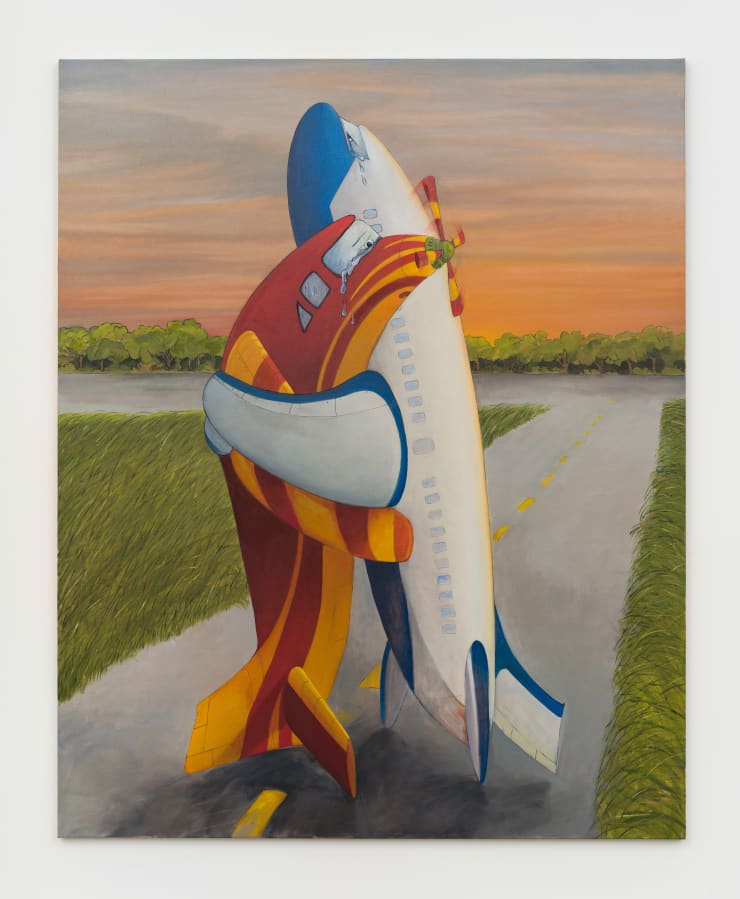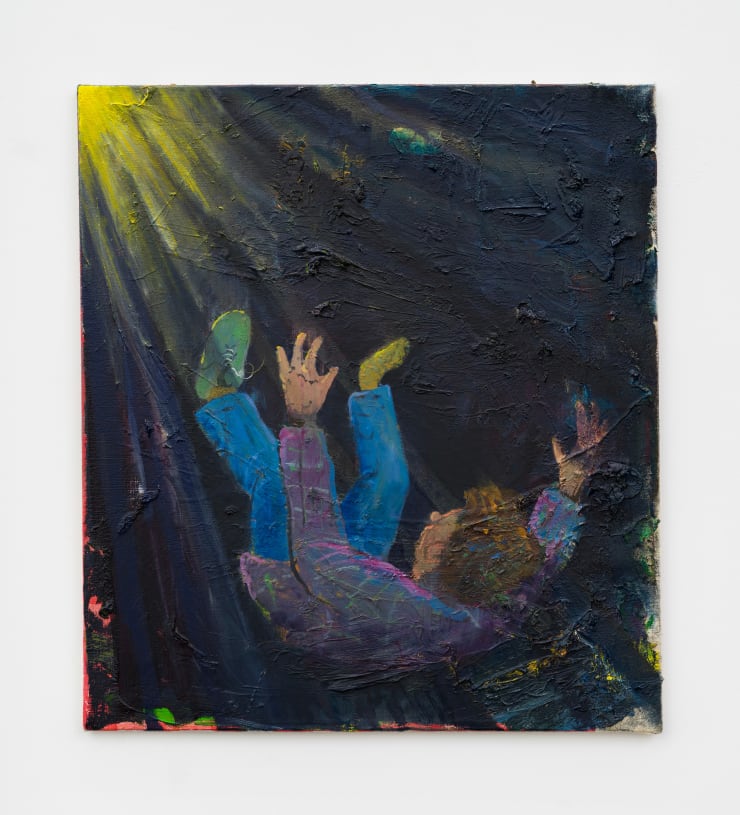Tristan Unrau "The Earth Not a Globe": Hollywood
Sebastian Gladstone presents, “The Earth Not a Globe'“, the first solo exhibition of new paintings by Tristan Unrau with the gallery. The Exhibition will open Saturday February 18th with an opening from 6-9PM at the Hollywood gallery.
"In Thomas Bernhard's Woodcutters, the narrator sits in the corner observing guests arriving at a dinner party hosted by old friends that he now detests. The narration that follows is a bitter indictment of the guests and the art scene of the Viennese bourgeoisie. But while he trashes everyone else, he can't deny his participation, the fact of his presence among them. What got him there, he admits, was that he "yielded himself to such disgraceful sentimentality."
Tristan Unrau approaches painting with a similar attitude. With a dark Bernhardian sense of humor about himself and the world, he witnesses his own moments of sentimentality and indulges in the romantic. Unrau draws on profane and reverent subject matter for this body of work, The Earth Not a Globe. In one painting, Azalea Pond, he'll give us a serene and technically impressive landscape; in another, Sucker, he reverses tone and pokes fun at the hubris of the last painting by showing a man bent over in the act of autofellatio. Though Sucker may allude to the often masturbatory quality of art making, Unrau is careful to avoid cynical irony, preferring a weirder sentimentality. He finds pathos in strange circumstances: two planes in a tearful embrace, a weepy cartoon blob imbibing, a sweating planet earth forced by the sun to play the flute.
Unrau paints in different styles not to show off his skill, but to attempt something more spiritually curious. He's trying to understand what it means for a painter to have a style - where does it come from, or how does it develop? If we can't rely on a consistent stylistic manner to analyze the work, we turn to the more ambiguous question of voice. What does the difference between style and voice look like, and what might the conditions for a pictorial practice be? The paintings collectively and humorously ask, "How does an artist find his voice?" Which leads to the more existential: how does one know oneself? By drawing on diverse references and techniques, Unrau can study this question, ultimately asking, "what's the difference between me and the rest of the world?"
Perhaps informed by his religious upbringing, Unrau's pictures reflect a search for meaning and skepticism with the artistic process. The paintings rattle with the anxiety of being stuck with ourselves, the absurdity of living in this world. This anxiety is most apparent in Adrien, a meticulously rendered portrait of a character from Eric Rohmer's La Collectionneuse. Rohmer's protagonists are always bourgeois subjects burdened by the comforts of their class and plagued by their political indifference and impotence. In the eponymous, The Earth Not a Globe, two airplanes tearfully embrace each other on a tarmac at dusk. Unrau mentioned coming up with the melodramatic motif years ago as a metaphor for a long-distance relationship he was in at the time. Still, it also functions as a political metaphor for the awkwardness with which nation-states console each other.
In Shambolic Figure, a cartoon blob monster sits in misery, clinging to a cocktail. This scene is lifted from a Warner Bros. cartoon in which Daffy Duck (voiced by the "velvet fog," Mel Torme) sings to a crowd of despondent monsters at a moody club. The song ends with the lyrics, "They're independent fellas they don't live nine to fives, monsters live such interesting lives," a reference to the cliche schedule of an "artist's" life. The palette of rich reds, yellows, and greens found throughout the show repeats in Odyssey, the closest Unrau comes to abstraction. However, referencing the wormhole sequence in Kubrick's Space Odyssey, the large textured painting avoids pure abstraction by seeming to depict an artist's rendering of a black hole, supernova, or quantum phenomenon. Whereas elsewhere in the show, the figures in the paintings are plagued by ennui, trapped in their bodies or confronted with the prospect of infinity, here we are offered a rendering of infinity itself, the absurdity of unimaginable scales and densities.
Sometimes Tristan drives me around LA in his convertible, and we have the same conversation over and over. He often talks about 'fate.' Here I am reminded of Interchange, a Suesseian portrayal of a tangle of freeways, a metaphor for the illusion of choice, and symbolic of his own stylistic twists and turns. We sometimes go to the same places, drive on the same freeways, and listen to the same songs, but each time something new happens, and each time we're a little bit older."
-Gracie Hadland
-
 Tristan Unrau, The Decider, 2022
Tristan Unrau, The Decider, 2022 -
 Tristan Unrau, Odyssey 2, 2022
Tristan Unrau, Odyssey 2, 2022 -
 Tristan Unrau, Azalea Pond, Central Park, 2022-23
Tristan Unrau, Azalea Pond, Central Park, 2022-23 -
 Tristan Unrau, The Earth Not A Globe, 2022
Tristan Unrau, The Earth Not A Globe, 2022 -
 Tristan Unrau, Submission, 2023
Tristan Unrau, Submission, 2023 -
 Tristan Unrau, Invitation, 2022-23
Tristan Unrau, Invitation, 2022-23 -
 Tristan Unrau, Interchange, 2022
Tristan Unrau, Interchange, 2022 -
 Tristan Unrau, Adrien, 2023
Tristan Unrau, Adrien, 2023 -
 Tristan Unrau, Sucker, 2022
Tristan Unrau, Sucker, 2022 -
 Tristan Unrau, Shambolic Figure, 2022
Tristan Unrau, Shambolic Figure, 2022 -
 Tristan Unrau, Study for Odyssey 2, 2022
Tristan Unrau, Study for Odyssey 2, 2022 -
 Tristan Unrau, Seascape, 2023
Tristan Unrau, Seascape, 2023 -
 Tristan Unrau, Condition, 2023
Tristan Unrau, Condition, 2023




























